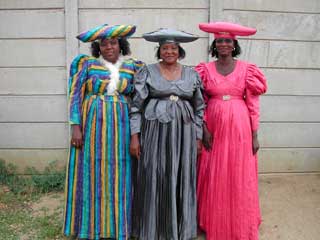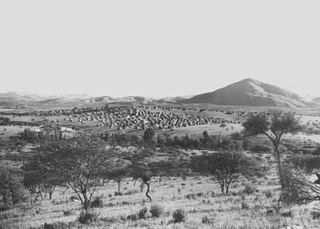The history of Namibia has passed through several distinct stages from being colonised in the late nineteenth century to Namibia's independence on 21 March 1990.

Windhoek, (pronunciation:), is the capital and largest city of the Republic of Namibia. It is located in central Namibia in the Khomas Highland plateau area, at around 1,700 metres (5,600 ft) above sea level, almost exactly at the country's geographical centre. The population of Windhoek in 2011 was 325,858, growing continually due to an influx from all over Namibia.
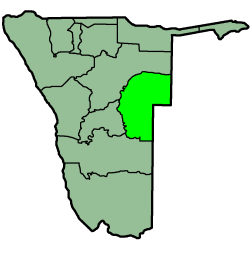
Omaheke is one of the fourteen regions of Namibia, its capital is Gobabis. It lies on the eastern border of Namibia and is the Western extension of the Kalahari desert. The name Omaheke is the Herero word for Sandveld.
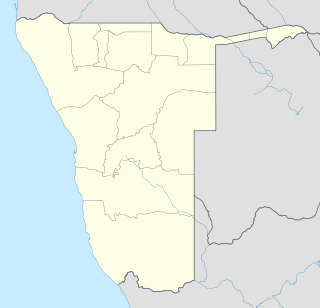
Otjiwarongo is a city of 28,000 inhabitants in the Otjozondjupa Region of Namibia. It is the district capital of the Otjiwarongo electoral constituency and also the capital of Otjozondjupa.
The Ovamboland People's Organization was a nationalist organization that existed between 1959 and 1960 in South West Africa. The aim of the organization was to end the South African colonial administration, and the placement of South West Africa under the United Nations Trusteeship system. Andimba Toivo ya Toivo had founded its predecessor, the Ovamboland People's Congress, in 1957 in Cape Town, South Africa. In 1959, Sam Nujoma and Jacob Kuhangua established the Ovamboland People's Organization (OPO) at the Old Location in Windhoek. Sam Nujoma was the president of OPO until its transformation into the South West Africa People's Organization (SWAPO) a year later and remained president until Namibia gained independence in 1990.
Clemens Kapuuo was a Namibian school teacher, shopkeeper, president of the Democratic Turnhalle Alliance (DTA), now called Popular Democratic Movement and chief of the Herero people of Namibia. Kapuuo was one of the leading opponents of South African rule of his country until his assassination following the Turnhalle Constitutional Conference.

The Heroes' Acre is an official war memorial of the Republic of Namibia. Built into the uninhabited hills c. 10 kilometres (6.2 mi) south of the city centre of Windhoek, Heroes' Acre opened on 26 August 2002 and operates for the purpose of "foster(ing) a spirit of patriotism and nationalism, and to pass on the legacy to the future generations of Namibia".
Gottlieb Wilhelm Eduard Redecker was a German engineer and architect in South West Africa. He was responsible for a number of important buildings which still stand today in Namibia, particularly in Windhoek, including the national assembly building, the Tintenpalast.
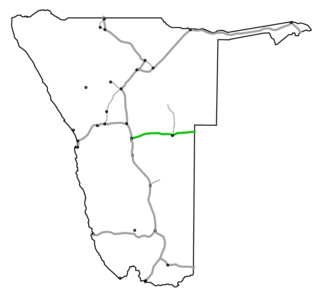
B6 is a national highway of eastern-central Namibia. It is 290 kilometres (180 mi) long and connects the capital Windhoek with the Buitepos border crossing to Botswana. Gobabis, the capital of Omaheke Region, lies on the B6, as do the villages of Seeis, Omitara and Witvlei. Hosea Kutako International Airport is also located on the B6, east of Windhoek.

Seeis is a small settlement in the Khomas Region of central Namibia. It is situated on the B6 national road 11 km (6.8 mi) east of Hosea Kutako International Airport on the turnoff of the dirt road D1458. The Seeis Rivier, an ephemeral river, cuts the settlement. Seeis is a railway stop on the Windhoek - Gobabis railway line.

Captain Hendrik Samuel Witbooi, Nama name: ǃGae-nûb ǃnagamâb ǃNansemab, was the sixth Kaptein of the ǀKhowesin, a subtribe of the Orlam, in the area of South-West Africa (SWA), today's Namibia. He was born in Gibeon; Hendrik Witbooi was his grandfather. He was selected to be the successor of his uncle David Witbooi who died in 1955.
The National Heritage Council of Namibia (NHC) is a government organization in Namibia responsible for historic preservation. It was created by the National Heritage Act of 2004, which is an act "to provide for the protection and conservation of places and objects of heritage significance and the registration of such places and objects; to establish a National Heritage Council; to establish a National Heritage Register; and to provide for incidental matters". It is managed by Rev S.M. April.

Franz Heinrich Kleinschmidt (1812–1864) was a German missionary and linguist who worked in southern Africa, now in the region of Namibia. He founded the missionary station and town of Rehoboth and together with Carl Hugo Hahn set up the first Rhenish mission station to the Herero people in Gross Barmen. Kleinschmidt is known for his scientific work on the Nama language.

Coloured people in Namibia are people with both European and African ancestry. Coloureds have immigrated to Namibia, been born in Namibia or returned to the country. These distinctively different periods of arrival, from diverse backgrounds and origins have led to a diverse Coloured population. This diversity was even further exploited by South African officials who referred to three distinct groups amongst the coloureds, namely: "Baster", "Cape Coloureds" and "Namibian Coloureds".
The Red Nation is the main subtribe of the Nama people in Namibia and the oldest Nama group speaking Khoekhoegowab, the language often called Damara/Nama.

Aminuis is a cluster of small settlements in the remote eastern part of the Omaheke Region of Namibia, located about 500 km east of Windhoek. It is the district capital of the Aminuis electoral constituency.



